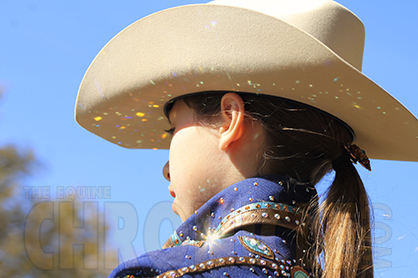AQHA Level 1 Championship Pattern Prep: L1 Horsemanship
The first leg of the 2016 AQHA Level 1 Championships is now underway in Oklahoma City! The Farnam AQHA Level 1 Championships CENTRAL began yesterday and will continue through April 16th. Then, the AQHA Level 1 Championship WEST will take place in Las Vegas, Nevada, April 20-24. Finally, the Nutrena AQHA Level 1 Championship EAST takes place in Raleigh, North Carolina, May 4-8.
For all of those novice and rookie competitors looking to put their best feet forward at this year’s Level 1 Championships, EquineChronicle.com is offering a bit of help with our Pattern Prep series. Follow along with an equine industry professional as he/she runs through the pattern, step by step, explaining the timing of transitions, the proper placement of maneuvers, and gives overall tips for success.
First up is the AQHA Level 1 Horsemanship pattern, which will be used for L1 Youth 13 and Under, L1 Youth 14-18, L1 Amateur, and L1 Select. Helping today is Cindy Monroe Young of Young Quarter Horses in Yadkinville, North Carolina. Young has coached many novice riders during her career as a trainer, and she thoroughly enjoys and appreciates their eagerness to learn.
Young emphasizes the importance of READING through a pattern’s elements in order to understand what’s being asked. “For example, in this pattern, the simple change through the jog, needs to be executed through the jog, not after a walk or stop. I would strongly encourage all exhibitors to read the rulebook to get an understanding of the criteria in a particular class beforehand.” Also, be sure to consider the note written on the pattern, which reads: “The drawn description of this pattern is only intended for the general depictions of the pattern. Contestants should utilize the arena space to best exhibit their horses.”
To begin, Young suggests taking a look at the entire pattern as a whole, checking to see which sides of the cones the rider will begin and end on, and then deciding where to place maneuvers within the cones. In this pattern, the horse and rider will begin with the cone on their left and end with the cone on their left. “We will go into the arena the night before and find ‘markers’ for the top, middle, and bottom of the pattern, such as banners, signs, or gates, that way riders don’t get lost while in the middle of a maneuver and they have an idea of where to place transitions and turns.”
Pattern Description:
1. Walk approximately 15′. “Starting with the cone on your left side, walk a good six to eight steps. This depends on how briskly your horse jogs off [for the next maneuver]. If your horse lags, I would start asking for the transition around the fifth step.”
2. Jog to center. “Execute a nice, solid, rhythmic jog to the point that you and your trainer determined to be the center of the pattern the night before.”
3. Stop. Execute an approximate 1 3/4 turn to left. “Approximate is the key word… this is to put you into position for a clean transition to the next maneuver.”
4. Lope, left lead circle. “This circle is slightly smaller than the second circle, therefore you must make sure to keep it well within the borders of the cones.” To help envision this, Young suggests to think about drawing two straight, vertical lines up from the cones that extend to the end of the page. In this pattern, both circles should stay within those boundaries, especially the small one, in order to show a difference in size between the two circles. “Spacing, shape, and flow are key elements.”
5. Simple change, through a jog. “Find the center spot where you executed your turn and ask for the jog slightly before. Jog two to three steps.”
6. Lope, right lead circle with speed. “This circle extends to the cones on the bottom and on the right side, but within the cone on the left side. This is where you need to know your horse. You need to know how much speed you can ask for. It does not need to be a Reining speed circle; it just needs to show that you can control your horse while asking for more speed than in the first circle.”
7. Collect to lope and extended trot to marker. “Know beforehand where you plan to start collecting your horse. This will be a spot well before the top/center of the circle. Make sure that you don’t lose all of your forward momentum during collection. Find your marker, turn the corner, and execute the extended trot transition. Proceed in a straight line to the inside of the cone.”
8. Stop and back. “Execute a nice, smooth, solid stop and back at least four to five steps in a straight line.”
9. Exit at a walk or jog. “I would suggest jogging out in order to open the pattern up for the next exhibitor.”
Click here to view schedules, patterns, and results from all the Level 1 Championships on AQHA.com.













